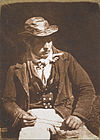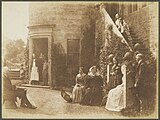 Composite photograph of Hill (left) and Adamson, both c. 1845 Composite photograph of Hill (left) and Adamson, both c. 1845 | |
| Formation | 1843 |
|---|---|
| Dissolved | 1848 |
| Purpose | Photography studio, producing salt prints from calotype negatives |
| Location |
|
| Coordinates | 55°57′16″N 3°11′07″W / 55.954361°N 3.185335°W / 55.954361; -3.185335 |
| Key people | |
| Affiliations | David Brewster |
Hill & Adamson was the first photography studio in Scotland, set up by painter David Octavius Hill and engineer Robert Adamson in 1843. During their brief partnership that ended with Adamson's untimely death, Hill & Adamson produced "the first substantial body of self-consciously artistic work using the newly invented medium of photography." Watercolorist John Harden, on first seeing Hill & Adamson's calotypes in November 1843, wrote, "The pictures produced are as Rembrandt's but improved, so like his style & the oldest & finest masters that doubtless a great progress in Portrait painting & effect must be the consequence."
Free Church of Scotland
Hill was present at the Disruption Assembly in 1843 when over 450 ministers walked out of the Church of Scotland assembly and down to another assembly hall to found the Free Church of Scotland. He decided to record the dramatic scene with the encouragement of his friend Lord Cockburn and another spectator, the physicist Sir David Brewster who suggested using the new invention, photography, to get likenesses of all the ministers present. Brewster was himself experimenting with this technology which only dated back to 1839, and he introduced Hill to another enthusiast, Robert Adamson. Hill & Adamson took a series of photographs of those who had been present and of the setting. The 5-foot x 11-foot 4 inches (1.53m x 3.45m) painting was eventually completed in 1866.
Photography studio

Their collaboration, with Adamson providing skill in composition and lighting, and Hill considerable sensitivity and dexterity in handling the camera, proved extremely successful, and they soon broadened their subject matter. Adamson's studio, "Rock House", on the Calton Hill in Edinburgh became the centre of their photographic experiments. Using the calotype process, they produced a wide range of portraits depicting well-known Scottish luminaries of the time, including Hugh Miller, both in the studio and in outdoors settings, often amongst the elaborate tombs in Greyfriars Kirkyard.
They photographed local and Fife landscapes and urban scenes, including images of the Scott Monument under construction in Edinburgh. As well as the great and the good, they photographed ordinary working folk, particularly the fishermen of Newhaven, and the fishwives who carried the fish in creels the 3 miles (5 km) uphill to the city of Edinburgh to sell them round the doors, with their cry of "Caller herrin" (fresh herring). They produced several groundbreaking "action" photographs of soldiers and – perhaps their most famous photograph – two priests walking side by side.
Their partnership produced around 3,000 different photographs, but was cut short after only four years due to the ill health and untimely death of Adamson in 1848. Hill became less active and abandoned the studio after several months, but continued to sell prints of the photographs and use them as an aid for composing paintings.
They had an assistant, Jessie Mann, who worked with them for at least three years until Adamson's death. Mann is a strong candidate for being considered the first Scottish woman photographer, and was one of the first women anywhere to be involved in photography. It is thought that Mann is the assistant that made the photograph of the King of Saxony in 1844, taken at the studio whilst Hill and Adamson were unavailable. A resulting print is now in the Scottish National Portrait Gallery.
Historical re-evaluation
For a time, art historians often credited the duo's photographic prints to Hill alone, with some adding a minor credit of "with Adamson". Modern critics recognise the importance of each man's input in the creation and execution of their photographic work, describing Adamson's earlier solo work as having been technically capable while lacking the flair and spontaneity shown in his work with Hill, and being critical of the poor quality of Hill's later work after Adamson's death.
Gallery
Selected artwork by Hill & Adamson-
 Edinburgh Ale, c1844
Edinburgh Ale, c1844
-
 Newhaven fisherman, 1845
Newhaven fisherman, 1845
-
 Newhaven Boy, c1845
Newhaven Boy, c1845
-
 St Andrews, North Street, Fishergate, c1845
St Andrews, North Street, Fishergate, c1845
-
 Dumbarton Presbytery, 1845, showing four ministers of the Free Church of Scotland, Princeton University Art Museum
Dumbarton Presbytery, 1845, showing four ministers of the Free Church of Scotland, Princeton University Art Museum
-
 Trinity College Chapel and Hospital, with Calton Hill in the background, 1840s
Trinity College Chapel and Hospital, with Calton Hill in the background, 1840s
-
 The Scott Monument (May 2, 1845)
The Scott Monument (May 2, 1845)
-
 Lord Cockburn (1779-1854) Solicitor General for Scotland and Lord Rector of Glasgow University. He was involved with Hill in establishing the Royal Scottish Academy. He is pictured here at Bonaly Tower in Colinton.
Lord Cockburn (1779-1854) Solicitor General for Scotland and Lord Rector of Glasgow University. He was involved with Hill in establishing the Royal Scottish Academy. He is pictured here at Bonaly Tower in Colinton.
Notes
- Union List of Artist Names
- ^ Daniel, Malcolm (2004). Heilbrunn Timeline of Art History.
- ^ Michaelson, Katherine (1970). Scottish Arts Council
- "Rock House". Rock House.
- ^ John Hannavy (2007). Encyclopedia of Nineteenth-century Photography. Taylor & Francis. p. 888. ISBN 978-1-135-87326-4. Archived from the original on 15 May 2016.
- Crompton, Sarah (6 May 2015). "She takes a good picture: six forgotten female pioneers of photography". The Guardian. London. Archived from the original on 9 May 2016. Retrieved 12 May 2016.
- Roddy Simpson (2012). The Photography of Victorian Scotland. Edinburgh University Press. pp. 27–28. ISBN 978-0-7486-5464-2.
- ^ Miller, Phil (13 April 2011). "Scottish woman who was a camera pioneer". Glasgow: The Herald (Glasgow). Archived from the original on 4 June 2016. Retrieved 12 May 2016.
- Miller, Phil (16 April 2016). "Is this the mysterious Scottish woman who helped pioneer photography?". Glasgow: The Herald (Glasgow). Archived from the original on 4 June 2016. Retrieved 12 May 2016.
- University of Glasgow Library, Hill & Adamson Biographies
References
- "Union List of Artist Names". J. Paul Getty Trust. 2004. Retrieved 4 March 2012.
- Daniel, Malcolm (October 2004). "David Octavius Hill (1802–1870) and Robert Adamson (1821–1848) (1840s)". Heilbrunn Timeline of Art History. The Metropolitan Museum of Art. Archived from the original on 25 February 2012. Retrieved 4 March 2012.
- Michaelson, Katherine (1970). David Octavius Hill 1802–1870 & Robert Adamson 1821–1848. Edinburgh: Scottish Arts Council.
- "Hill & Adamson Biographies". University of Glasgow Library. Archived from the original on 13 October 2012. Retrieved 4 March 2012.
External links
- Hill & Adamson Collection at Art Institute of Chicago
- Hill & Adamson Collection Archived 4 March 2016 at the Wayback Machine at Capital Collections
- Hill & Adamson Collection at George Eastman House
- Hill & Adamson Collection at Glasgow School of Art Flickr photostream
- Hill & Adamson Collection at Google Art Project
- Hill & Adamson Collection at J. Paul Getty Museum
- Hill & Adamson Collection at Library of Congress
- Hill & Adamson Collection at National Gallery of Art
- Hill & Adamson Collection at National Gallery of Canada
- Hill & Adamson Collection at National Gallery of Scotland
- Hill & Adamson Collection at National Portrait Gallery, London
- Hill & Adamson Collection at Metropolitan Museum of Art
- Hill & Adamson Collection at Preus Museum Flickr photostream
- Hill & Adamson Collection at Rijksmuseum
- Hill & Adamson Collection at San Francisco Museum of Modern Art
- Hill & Adamson Collection at University of Edinburgh
- Hill & Adamson Collection at Victoria & Albert Museum
- Pioneers of photography
- 19th-century Scottish photographers
- 1843 establishments in Scotland
- Companies based in Edinburgh
- Calton Hill
- Photographic studios
- Defunct photography companies
- Defunct companies of Scotland
- Photography companies of Scotland
- Scottish photographers
- 1848 disestablishments in the United Kingdom